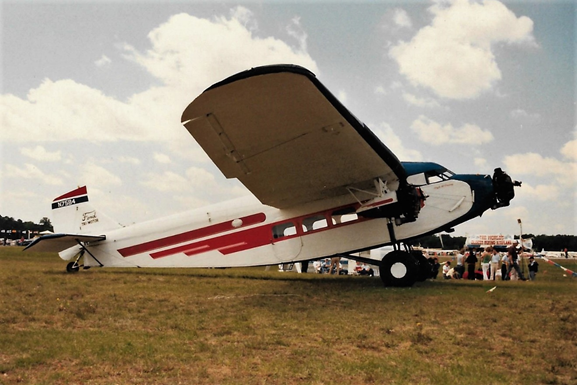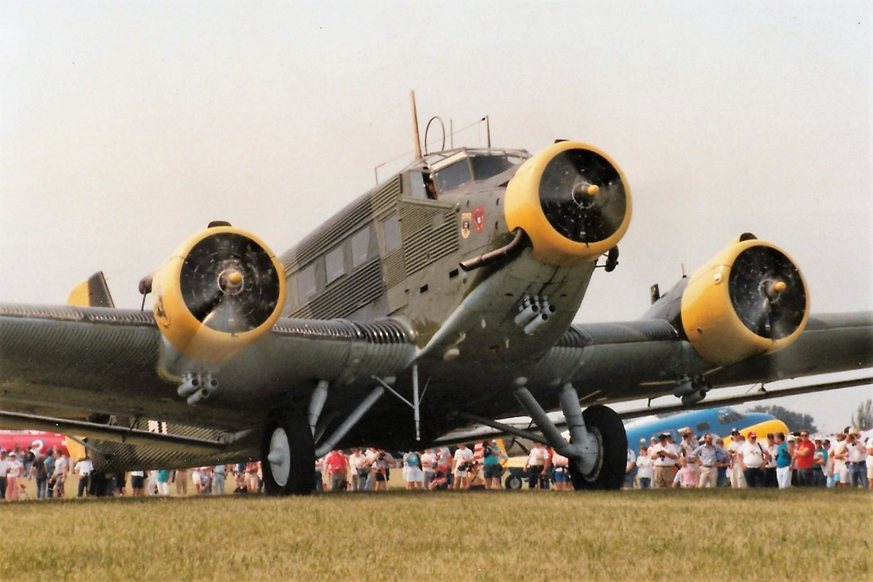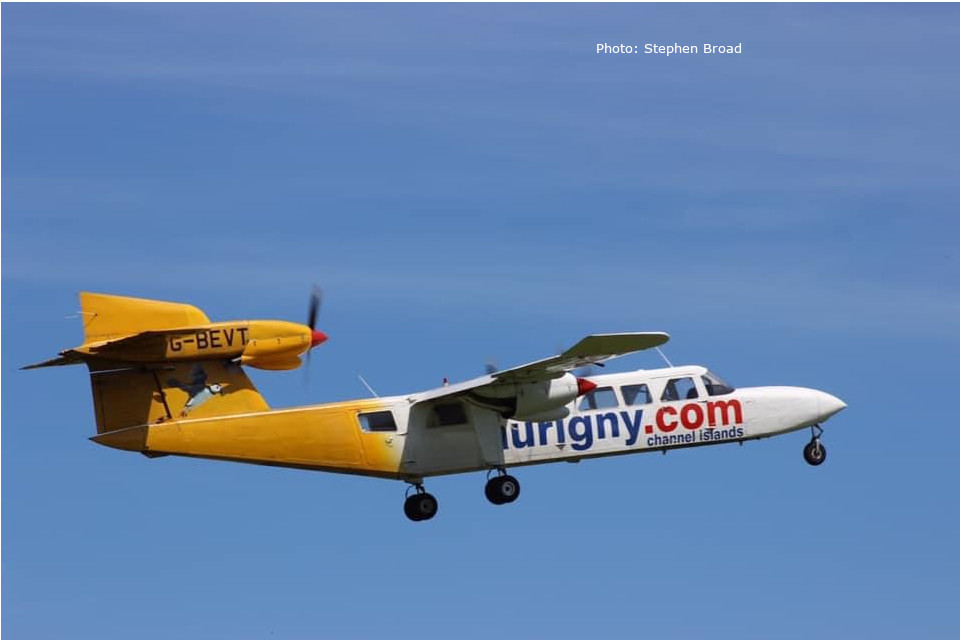


Those of you who follow our Facebook page may well remember a recent run of posts covering three-engine jets such as the Trident, DC-10, Tristar and Boeing 727. This engine arrangement was nothing new as we shall see in this article about some early piston engine tri-motor aircraft.

The first tri-motor plane built would appear to be the Batson Air Yacht. Designed to cross the Atlantic, it was a seaplane designed and built in the USA in 1913. Sadly it never flew having sunk at its moorings before the maiden flight. The first successful tri-motor to fly and enter production was the Italian Caproni ca.1 bomber. Flying for the first time in 1914, production would see 162 examples being built.

From these early days a surprisingly large number of tri-motors would be produced from all the major manufacturers of the time. Their heyday was the 1920s-1930s, however as we at the British Airliner Collection well know, even as late as 1970 new tri-motors were being produced in the shape of the Britten-Norman Trislander. The first British tri-motor would be the AD Seaplane 1000, only one was produced first flying during the summer of 1916. Designed to carry a crew of five alongside a 12-pounder gun, this 64 feet long plane was the largest British aeroplane flying at the time. After the First World War thoughts turned to peace and the need for airliners. UK airline Imperial Airways had asked to see designs of new multi-engine aircraft for its routes. Armstrong- Whitworth offered their first ever airliner design - the Argosy. Still a bi-plane this new airliner was powered by three engines as even with huge engine development during the war, engines were still not very powerful or reliable and three gave better safety margins. Imperial liked the design and ordered the new airliner. First flying in March1926 the seven Argosies built would fly with Imperial until retirement in 1935.The last Argosy flying was operated by United Airways/British Airways until 1936.

It is hard to understand why British designers were so set in their ways. The Argosy’s sister plane the Handley Page HP-42 didn’t fly until 1930 but it was still a bi-plane. Across the North Sea the Dutch Fokker company had been building their Fokker F.v11a/3M since 1924, this three-engine monoplane was very popular with airlines around the world including those in the USA. Several Fokker aircraft were the mounts for record breaking flights including Kingsford-Smith’s first crossing of the Pacific by air when he flew from the US to Australia in 1928. Another record flight followed a few months later when he took his plane named Southern Cross over the Tasman Sea to New Zealand and back. Capable of seating 12 passengers, the Fokker tri-motor was the backbone of many US airlines until a crash in 1931 was blamed on the plywood-covered wing structure failing. This prompted the Fokkers rapid replacement with more modern all-metal aircraft such as the Boeing 247 and the Douglas DC-2.

First flying just three months after the British Argosy the American Ford Tri-motor affectionately known as the Tin Goose was a completely different kettle of fish to the British design. For a start the pilot was seated within the cabin and the aeroplane was a new modern monoplane similar to the much loved Fokker Tri-motor. It was however made entirely of aluminium which gave it the Tin Goose nickname. Like all Ford products of the time it had a reputation for value for money and reliability. This saw over 100 airlines operate the 199 examples made, even today a couple of Ford Tri-motors tour the US giving rides. By the early 1930s more modern aircraft were arriving onto the airliner scene and the Ford began to be replaced in the same way as the Fokker had given way to more modern designs earlier. Seeing this Henry Ford rather lost interest in aviation and concentrated on his car industry. However following the entry of the US into the Second World War Ford again dabbled in aviation when it turned over its huge Willow Run car plant at Detroit to building B-24 Liberators under licence from Consolidated.

The 1930s saw an explosion in new tri-motor designs from all over the world. The US Stinson company had flown both its Model A and Model 6000 aeroplanes and in the UK Airspeed built four examples of their Airspeed Ferry in 1932 for the Alan Cobham pleasure flying company. The Czech manufacturer Avia joined in with the six passenger model 51 and in France Bloch were busy building 11 MB.120 airliners, six of which went to Air Afrique. But for large-scale tri-motor production we have to look to Italy and Germany. The Italian company Savoia Marchetti built a string of tri-motor models from the eight seat S.71 of 1930 through transports and bombers to the S.82 of 1939. Perhaps the best known of all the tri-motor designs first flew in Germany when Hugo Junker’s JU-52 first took to the sky in 1930. With airline and military use 4845 examples of this rugged corrugated skin design would be built.

Savoia (later to become Savoia-Marchetti) first flew their eight seater model S.71 in 1930. Only four examples of this small tri-motor would be built but they paved the way for a large range of similarly powered aircraft from the Italian firm. Founded in 1915 Savoia had become well known for its float and sea planes with some of their products breaking several records for endurance and speed. From this experience had come the land based S.71 in 1930. With a crew of four for just eight passengers only seven would be built.

Following the renaming of the company to Savoia-Marchetti after their chief designer Marchetti, in 1934 the company launched its SM.73, an airliner capable of carrying 18 passengers. Around 50 would be built and saw service with Sabena, CSA of Czechoslovakia, and ALA Littoria airlines of Italy. The Italian Air Force also operated the type. In 1940 several captured SM.73s were flown to the UK and operated by the allies. In 1934 alongside the SM.73 the company had also built the SM.79 designed as a fast eight seat passenger aircraft. The military took an interest and in a similar vein to the British Bristol Blenheim had it adapted into a fast bomber. This would be the most produced tri-motor from the Italian company with 1240 being built mainly as bombers and it became the standard bomber for the Italian Air Force during the Second World War. It remained in ITAF service until 1952.

One of the last Savoia-Marchetti trimotor designs was the 1939 built SM.82 which was designed as a bomber or transport. It is thought most were used in the transport role with many flying with the Luftwaffe. The SM.82 continued flying with the Italian Air Force up until the early 1960s. They were capable of carrying 14 passengers and 727 were built.

Probably the best known tri-motor and certainly the most produced was the Junkers Ju-52 Tante -Ju. First flying in October 1930 the Ju-52 was initially designed with just one engine but was quickly adapted to the three-engine layout we are used to seeing today. Because of the change of engine layout, the aircraft was now known as the Ju-52/3M for three motors. Flown throughout the 1930 as a 17 seat airliner several airlines cut their teeth on this all metal tri-plane including Swissair and Lufthansa, even BEA flew them after the war. It was of course its war service with the Luftwaffe that forged its name in the history of modern day aviation, used as a transport, parachute platform and even a bomber the Ju-52 operated in all theatres of the war and at the end of hostilities could also be seen in service with the Swiss, French, Spanish and Portuguese Air Forces with production continuing in both Spain and France. In the years following the war Ju-52s could be seen in service with air forces and airlines around the world such was the demand for this rugged go anywhere aeroplane. Some were up to very recent times operated on sightseeing flights, but following a crash of a Swiss JuAir machine and the retirement of the Lufthansa example I believe these have now been stopped.


With the advent of more powerful and reliable engines the three engine concept mainly fell out of fashion after the Second world war however there will always be a design or two that tries to buck the trend. de Haviland Australia were looking at producing an aircraft to replace the Dragon Rapide on many of their internal short flights and in 1948 they came up with a tri motor design developed from the DH Dove called the DHA-3 Drover. Carrying 9 passengers 20 of these useful little aeroplanes would be produced. The Drover would be operated by several airlines in and around Australia including Qantas and Trans Australia. The Flying Doctor Service also used the Drover but it suffered from lack of power and propeller problems.

With a host of cheap war surplus cargo aeroplanes available a large number of eyebrows were raised when in 1946 the Northrop company flew its N-23 Pioneer, a tri-motor STOL cargo plane. Only the USAF expressed an interest and re named the plane the C-125 Raider, they ordered 23 which would be the total production run. Deliveries began in 1950, but the new plane was not a success and all examples were rapidly delivered to a training base as ground instruction airframes. By 1955 all had been declared surplus and ended up being sold to various bush operators who appreciated the short take off and landing distances required. Only two survived and both now reside in museums at Pima and Dayton in the USA.

That brings us to the end of this quick look at piston tri-motors but we will end with another photo of the most prolific the unique Ju-52.

‘till the next time Keith
Editors footnote:
It wouldn't be right to finish this article without including our very own piston trimotor.
The Britten-Norman BN2A MkIII Trislander was developed from the twin engined Islander to satisfy custmer demands for a larger aircraft.
Remarkably designed and built in less than 6 months it first flew in 1970 (the same year as 2 very different trimotors the Lockheed L1011 Tristar and McDonnell Douglas DC10!). Although only in production for 5 years, examples are still flying 51 years later.
The Trislander was the only propeller aircraft to mount the third engine in the tail (unless you know of another?)

Registered Charity No. 285809